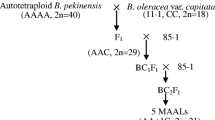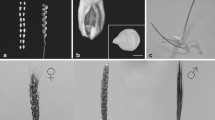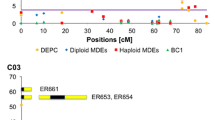Abstract
We have undertaken the construction of a Brassica napus genetic map with isozyme (4%), RFLP (26.5%) and RAPD (68%) markers on a 152 lines of a doubled-haploid population. The map covers 1765 cM and comprises 254 markers including three PCR-specific markers and a morphological marker. They are assembled into 19 linkage groups, covering approximatively 71% of the rapeseed genome. Thirty five percent of the studied markers did not segregate according to the expected Mendelian ratio and tended to cluster in eight specific linkage groups. In this paper, the structure of the genetic map is described and the existence of non-Mendelian segregations in linkage analysis as well as the origins of the observed distortions, are discussed. The mapped RFLP loci corresponded to the cDNAs already used to construct B. napus maps. The first results of intraspecific comparative mapping are presented.
Similar content being viewed by others
References
Armstrong CL, Rovero-Severson J, Hodges TK (1992) Improved tissue culture response of an elite maize inbred through backcross breeding and identification of chromosomal regions important for regeneration by RFLP analysis. Theor Appl Genet 84:755–762
Arondel V, Lemieux B, Hwang I, Gibson S, Goodman HM, Somerville CR (1992) Map-based cloning of a gene controlling omega-3 fatty acid desaturation in Arabidopsis. Science 258:1353–1354
Arus P, Orton TJ (1983) Inheritance and linkage relationships of isozyme loci in Brassica oleracea. J Hered 74:405–412
Bailey NTJ (1949) The estimation of linkage with differential viability, II and III. Heredity 3:220–228
Bell CJ, Ecker JR (1994) Assignment of 30 microsatellites loci to the linkage map of Arabidopsis. Genomics 19:137–144
Bentolila S, Hardy T, Guitton C, Freyssinet G (1992) Comparative genetic analyses of F2 plants and anther-culture-derived plants of maize. Genome 35:575–582
Bohuon E, Keith D, Parkin I, Sharpe A, Lydiate D (1994) The genome of modern Brassica oleracea is identical to the C genome of Brassica napus. Colloque “Techniques et Utilisations des Marqueurs Moléculaires”, Montpellier mars 94, France, 100
Brace J, Ryder CD, Ockendon DJ (1994) Identification of S-alleles in Brassica oleracea. Euphytica 80:229–234
Chakravarti A, Lasher LK, Reefer JE (1991) A maximum-likelihood method for estimating genome length using genetic linkage data. Genetics 128:175–182
Chang C, Bowman JL, De John AW, Lander ES, Meyerowitz EM (1988) Restriction fragment length polymorphism linkage map for Arabidopsis thaliana. Proc Natl Acad Sci USA 85:6856–6860
Chèvre AM, Delourme R, Eber F, Margale E, Quiros CF, Arus P (1995) Genetic analysis and nomenclature for seven isozyme systems in Brassica nigra, B. oleracea and B. campestris. Plant Breed 114:473–480
Chyi YS, Hoenecke ME, Sernyk JL (1992) A genetic linkage map of restriction fragment length polymorphism loci for Brassica rapa (syn. campestris). Genome 35:746–757
Chyi YS, Hoenecke ME, Sernyk JL (1994) Chromosome locations of the Sr gene in the three Brassica species. Cruciferae Newslett 16:41
Cloutier S (1994) Cartographie génétique comparative de deux types de populations de canola (Brassica napus L.). PhD thesis, University of Montreal, Canada
Cloutier S, Cappadocia M, Landry BS (1995) Study of microspore culture responsiveness in oilseed rape (Brassica napus L.) by comparative mapping of a F2 population and two microsporederived populations. Theor Appl Genet 91:841–847
Delourme R, Foisset N (1991) Isozyme variability in Brassica napus. Proc 8th Int Rapessed Conf, Saskatoon, Canada, 4, pp 1055–1060
Doyle JJ, Doyle JL (1990). Isolation of plant DNA from fresh tissue. Focus 12:13–15
Ferreira ME, Williams PH, Osborn TC (1994) RFLP mapping of Brassica napus using doubled-haploid lines. Theor Appl Genet 89:615–621
Foisset N, Delourme R (1996) Segregation distortion in androgenic plants. In: Mohan Jain S, Sopory SK, Veilleux RE (Eds) In vitro haploid production in higher plants. Kluwer Academic Publisher, Dordrecht, Netherlands, vol 2:189–201
Foisset N, Delourme R, Barret P, Renard M (1995) Molecular tagging of the dwarf Breizh (Bzh) gene in Brassica napus. Theor Appl Genet 91:756–761
Foisset N, Delourme R, Renard M (1996) In vitro androgenesis and segregation distortion in Brassica napus L.: spontaneous versus colchicine doubled lines. Plant Cell Rep (in press)
Graner A, Jahoor A, Schondelmaier J, Siedler H, Pillen K, Fischbeck G, Wenzel G, Herrmann RG (1991) Construction of an RFLP map of barley. Theor Appl Genet 83:250–256
Harada JJ, Baden CS, Lomai L (1988) Spatially regulated genes expressed during seed germination and post-germinative development are activated during embryogeny. Mol Gen Genet 212:466–473
Hauge BM, Hanley SM, Cartinhour S, Cherry JM, Goodman HM, Koorneef M, Stam P, Chang C, Kempin S, Medrano L, Meyerowitz EM (1993) An integrated genetic/RFLP map of the Arabidopsis thaliana genome. Plant J 3:745–754
Heun M, Kennedy AE, Anderson JA, Lapitan NLV, Sorrels ME, Tanksley SD (1991) Construction of a restriction fragment length polymorphism map for barley (Hordeum vulgare). Genome 34:437–447
Jones GH (1994) The control of chiasma distribution. In: INRA (eds) Groupe de travail “Cytologie et Cytogénétique”, Bretenieres, pp 7–10
Jourdren C, Barret P, Brunel D, Delourme R, Renard M (1996a) Specific molecular marker of the gene controlling the linolenic acid level in rapeseed. Theor Appl Genet 93:512–518
Jourdren C, Barret P, Horvais R, Delourme R, Renard M (1996b) Identification of RAPD markers linked to linolenic acid level in rapeseed. Euphytica 90:351–357
Jourdren C, Barret P, Horvais R, Foisset N, Delourme R, Renard M (1996c). Identification of RAPD markers linked to the loci controlling erucic acid level in rapeseed. Mol Breed 2:61–71
Kesseli RV, Paran I, Michelmore RW (1992) Efficient mapping of specifically targeted genomic regions and the tagging of these regions with reliable PCR-based genetic markers. Applications of RAPD technology to plant breeding. Joint Plant Breeding Symposia Series. 1November 1992, Mineapolis Minnesota, pp 31–36
Kianian SF, Quiros CF (1992) Genetic analysis of major multigene families in Brassica oleracea and related species. Genome 35:516–527
Koornneef M, Van Eden J, Hanhart CJ, Stam P, Braaksma FJ, Feenstra WJ (1983) Linkage map of Arabidopsis thaliana. J Hered 74:265–272
Kosambi DD (1944) The estimation of map distance from recombination values. Ann Eugen 12:172–175
Kowalski SP, Lan TH, Feldmann A, Paterson AH (1994) Comparative mapping of Arabidopsis thaliana and Brassica oleracea chromosomes reveals islands of conserved organization. Genetics 138:499–510
Lagercrantz U, Lydiate DJ (1995) RFLP mapping in Brassica nigra indicates differing recombination rates in male and female meioses. Genome 38:255–264
Lander ES, Green P, Abrahamson J, Barlow A, Daly MJ, Lincoln SE, Newburg I (1987) MAPMAKER: an interactive computer package for constructing primary genetic linkage maps of experimental and natural populations. Genomics 1:174–181
Landry BS, Hubert N, Etoh T, Harada JJ, Lincoln SE (1991) A genetic map for Brassica napus based on restriction fragment length polymorphism detected with expressed DNA sequences. Genome 34:543–552
Landry BS, Hubert N, Crete R, Chang MS, Lincoln SE, Etoh T (1992) A genetic map for Brassica oleracea based on RFLP markers detected with expressed DNA sequences and mapping of resistance genes to race 2 of Plasmodiophora brassicae (Woronin). Genome 35:409–420
Lange K, Boehnke M (1982) How many polymorphic marker genes will it take to span the human genome? Am J Hum Genet 34:842–845
Le Corre D, Barbeyron G, Guidet F (1994) RFLP mapping of cauliflower (Brassica oleracea var botrytis) using cold labelled probes. Colloque ‘Techniques et Utilisations des Marqueurs Moléculaires’, Montpellier mars 94, France, 56
Lefèbvre V (1993) Marquage moléculaire et analyse de résistances polygéniques. Interaction piment (Capsicum annuum L.) —Phytophtora capsici Leon. Thèse de l'université de Paris Xi-Orsay, France
Lister C, Dean C (1993) Recombinant inbred lines for mapping RFLP and phenotypic markers in Arabidopsis thaliana. Plant J 4:745–750
Lincoln SE, Daly MJ, Lander ES (1992) Constructing genetic linkage maps with Mapmaker/Exp 3.0: a tutorial and reference manual. Whitehead Institute Technical Report 3rd edn
Lorieux M, Goffinet B, Perrier X, Gonzales De Leon D, Lanaud C (1995a) Maximum-likelihood models for mapping genetic markers showing segregation distortion. 1. Backcross populations. Theor Appl Genet 90:73–80
Lorieux M, Perrier X, Goffinet B, Lanaud C, Gonzales De Leon D (1995b) Maximum-likelihood models for mapping genetic markers showing segregation distortion. 2. F2 populations. Theor Appl Genet 90:81–89
Lukaszewski AJ, Curtis CA (1993) Physical distribution of recombination in B-genome chromosomes of tetraploid wheat. Theor Appl Genet 86:121–127
Lydiate DJ, Sharpe AG, Lagercrantz U, Parkin I (1993) Mapping the Brassica genome. Outlook Agric 2:85–92
Mather K (1957) The measurement of linkage in heredity. Methuen and Co, London
Michelmore RW, Paran I, Kesseli RV (1991) Identification of markers linked to disease-resistance genes by bulked segregant analysis: A rapid method to detect markers in specific regions by using segregating populations. Proc Natl Acad Sci USA 88:9828–9832
McGrath JM, Quiros CF (1991) Inheritance of isozyme and RFLP markers in Brassica campestris and comparison with B. oleracea. Theor Appl Genet 82:668–673
McGrath JM, Jancso MM, Pichersky E (1993) Duplicate sequences with a similarity to expressed genes in the genome of Arabidopsis thaliana. Theor Appl Genet 86:880–888
Mohapatra T, Sharma A, Upadhyay A, Chopra VL, Sharma RP (1995) RFLP mapping in indian mustard (Brassica juncea). Cruciferae Newslett 17:22–23
Morton N (1955) Sequential tests for the detection of linkage. Am J Hum Genet 7:277–318
Murigneux A, Baud S, Beckert M (1993) Molecular and morphological evaluation of doubled-haploid lines in maize. 2. Comparison with single-seed-descent lines. Theor Appl Genet 87:278–287
Nam HG, Giraudat J, Den Boer B, Moonan F, Loos WDB, Hauge BM, Goodman HM (1989) Restriction fragment length polymorphism linkage map of Arabidopsis thaliana. Plant Cell 1:699–705
Parkin IAP, Sharpe AG, Keith DJ, Lydiate DJ (1995) Identification of the A and C genomes of amphidiploid Brassica napus (oilseed rape) Genome 38:1122–1131
Polsoni L, Kott S, Beversdorf WD (1988) Large-scale microspore culture technique for mutation-selection studies in Brassica napus. Can J Bot 66:1681–1685
Reiter RS, Williams JGK, Feldmann KA, Rafalski JA, Tingey SV, Scolnik PA (1992) Global and local genome mapping in Arabidopsis thaliana by using recombinant inbred lines and random amplified polymorphic DNAs. Proc Natl Acad Sci USA 89: 1477–1481
Sharpe AG, Parkin IAP, Keith DJ, Lydiate DJ (1995) Frequent nonreciprocal translocations in the amphidiploid genome of oilseed rape (Brassica napus). Genome 38:1112–1121
Shields CR, Orton TJ, Stuber CW (1983) An outline of general resource needs and procedures for the electrophoretic separation of active enzymes from plant tissues. In: Tanksley SD, Orton TJ (eds) Isozymes in plant genetics and breeding, part A. Elsevier Science Publishers, Amsterdam, pp 443–468
Simon AE, Tenbarge KM, Scofield SR, Finkelstein RR, Crouch ML (1985) Nucleotide sequence of a cDNA clone of Brassica napus 12s storage protein shows homology with legumin from Pisum sativum. Plant Mol Biol 5:191–201
Slocum MK, Figdore SS, Kennard WC, Suzuki JY, Osborn TC (1990) Linkage arrangement of restriction fragment length polymorphism loci in Brassica oleracea. Theor Appl Genet 80:57–64
Song KM, Suzuki JY, Slocum MK, Williams PH, Osborn TC (1991) A linkage map of Brassica rapa (syn. campestris) based on restriction fragment length polymorphism loci. Theor Appl Genet 82:296–304
Tanksley SD, Ganal MW, Prince JP, De Vicente MC, Bonierbale MW, Broun P, Fulton TM, Giovannoni JJ, Grandillo S, Martin GB, Messeguer R, Miller JC, Miller L, Paterson AH, Pineda O, Roder MS, Wing RA, WU W, Young ND (1992) High-density molecular linkage map of tomato and potato genomes. Genetics 132:1141–1160
Teutonico RA, Osborn TC (1994) Mapping of RFLP and qualitative trait loci in Brassica rapa and comparison to the linkage maps of B. napus, B. oleracea, and Arabidopsis thaliana. Theor Appl Genet 89:885–894
Truco MJ, Quiros CF (1994) Structure and organisation of the B genome based on a linkage map in Brassica nigra. Theor Appl Genet 89:590–598
U N (1935) Genomic analysis in Brassica with special reference to the experimental formation of B. napus and its peculiar mode of fertilization. Jpn J Bot 7:389–452
Uzunova M, Ecke W, Weissleder K, Röbbelen G (1995) Mapping the genome of rapeseed (Brassica napus L.). I. Construction of an RFLP linkage map and localization of QTLs for seed glucosinolate content. Theor Appl Genet 90:194–204
Vallejos CE (1983) Enzyme activity staining. In: Tanksley SD, Orton TJ (eds) Isozymes in plant genetics and breeding, part A. Elsevier Science Publishers, Amsterdam, pp 469–516
Wan Y, Rocheford TR, Widholm JM (1992) RFLP analysis to identify putative chromosomal regions involved in the anther culture response and callus formation of maize. Theor Appl Genet 85:360–365
Wendel JF, Stuber CW (1984) Plant isozymes: enzymes studied and buffer systems for their electrophoretic resolution in starch gels. Isozyme Bull 17:4–11
Williams JGK, Kubelik AR, Livak KJ, Rafalski JA, Tingey SV (1990) DNA polymorphisms amplified by arbitrary primers are useful as genetic markers. Nucleic Acids Research 18:6531–6535
Author information
Authors and Affiliations
Additional information
Communicated by G. Wenzel
Rights and permissions
About this article
Cite this article
Foisset, N., Delourme, R., Barret, P. et al. Molecular-mapping analysis in Brassica napus using isozyme, RAPD and RFLP markers on a doubled-haploid progeny. Theoret. Appl. Genetics 93, 1017–1025 (1996). https://doi.org/10.1007/BF00230119
Received:
Accepted:
Issue Date:
DOI: https://doi.org/10.1007/BF00230119




